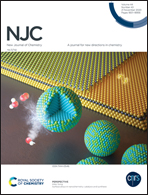A combined experimental and DFT approach on free radical induced oxidations of kynurenic acid†
Abstract
Kynurenic acid (KA) is a secondary metabolite of tryptophan degradation via the kynurenine pathway. Herein, we report the spectra and kinetics of transients derived from the one electron oxidations of KA by hydroxyl radical (˙OH), sulfate radical anion (SO4˙−) and oxide radical ion (O˙−) in water. Using cyclic voltammetry, the (KA˙+/KA) reduction potential of KA was found to be 1.5 V (vs. NHE). Transient absorption spectra obtained in the reactions of ˙OH with KA in the pH range of 4–9 were characterized by two bands centered at 370 nm and 470 nm. A bimolecular rate constant (k2) of 5.8 ± 0.02 × 109 M−1 s−1 at pH 6.8 was determined for the reaction of ˙OH with KA. The radical adduct formation (RAF) of ˙OH with KA has been elucidated using B3LYP/6-311+G(d,p)/SMD(water) level calculations. In the SO4˙− reactions at pH 6.8, we obtained a transient spectrum at 2 μs with λmax = 390 nm, which got transformed at higher time scales with λmax at 370 nm. The primary transient in the SO4˙− reaction was attributed to the KA radical cation (KA˙+) via a single electron transfer (SET) mechanism; then KA˙+ undergoes a decarboxylation reaction with a concurrent intramolecular H-atom shift to yield another radical. Transient spectra with λmax at 390 nm and 460 nm have been obtained in the reactions of O˙− with a doubly charged negative ion of KA at pH ≈ 14. Using DFT calculations, we identified that two simultaneous mechanisms are operative in the O˙− reactions. The first one corresponds to a SET mechanism, while the addition of O˙− followed by fast protonation by H2O accounts for the second pathway. Additionally, we studied the efficacy of KA against ˙OH induced lipid peroxidation of lecithin liposomes using the thiobarbituric acid reactive substance (TBARS) assay. The half-maximal inhibitory concentration (IC50) of KA for the reduction of lipid peroxidation was determined to be 168 μM. We believe that the findings of this work are noteworthy for gaining further knowledge on the reactivity of biological oxidants towards KA and its antioxidant or radical scavenging abilities.



 Please wait while we load your content...
Please wait while we load your content...